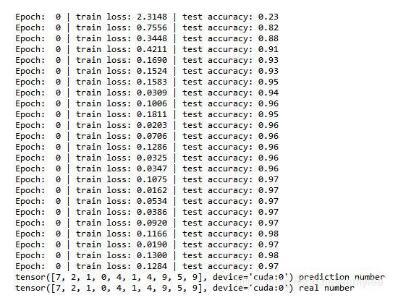硬件:NVIDIA-GTX1080
软件:Windows7、python3.6.5、pytorch-gpu-0.4.1
一、基础知识
将数据和网络都推到GPU,接上.cuda()
二、代码展示
import torch import torch.nn as nn import torch.utils.data as Data import torchvision # torch.manual_seed(1) EPOCH = 1 BATCH_SIZE = 50 LR = 0.001 DOWNLOAD_MNIST = False train_data = torchvision.datasets.MNIST(root='./mnist/', train=True, transform=torchvision.transforms.ToTensor(), download=DOWNLOAD_MNIST,) train_loader = Data.DataLoader(dataset=train_data, batch_size=BATCH_SIZE, shuffle=True) test_data = torchvision.datasets.MNIST(root='./mnist/', train=False) # !!!!!!!! Change in here !!!!!!!!! # test_x = torch.unsqueeze(test_data.test_data, dim=1).type(torch.FloatTensor)[:2000].cuda()/255. # Tensor on GPU test_y = test_data.test_labels[:2000].cuda() class CNN(nn.Module): def __init__(self): super(CNN, self).__init__() self.conv1 = nn.Sequential(nn.Conv2d(in_channels=1, out_channels=16, kernel_size=5, stride=1, padding=2,), nn.ReLU(), nn.MaxPool2d(kernel_size=2),) self.conv2 = nn.Sequential(nn.Conv2d(16, 32, 5, 1, 2), nn.ReLU(), nn.MaxPool2d(2),) self.out = nn.Linear(32 * 7 * 7, 10) def forward(self, x): x = self.conv1(x) x = self.conv2(x) x = x.view(x.size(0), -1) output = self.out(x) return output cnn = CNN() # !!!!!!!! Change in here !!!!!!!!! # cnn.cuda() # Moves all model parameters and buffers to the GPU. optimizer = torch.optim.Adam(cnn.parameters(), lr=LR) loss_func = nn.CrossEntropyLoss() for epoch in range(EPOCH): for step, (x, y) in enumerate(train_loader): # !!!!!!!! Change in here !!!!!!!!! # b_x = x.cuda() # Tensor on GPU b_y = y.cuda() # Tensor on GPU output = cnn(b_x) loss = loss_func(output, b_y) optimizer.zero_grad() loss.backward() optimizer.step() if step % 50 == 0: test_output = cnn(test_x) # !!!!!!!! Change in here !!!!!!!!! # pred_y = torch.max(test_output, 1)[1].cuda().data # move the computation in GPU accuracy = torch.sum(pred_y == test_y).type(torch.FloatTensor) / test_y.size(0) print('Epoch: ', epoch, '| train loss: %.4f' % loss, '| test accuracy: %.2f' % accuracy) test_output = cnn(test_x[:10]) # !!!!!!!! Change in here !!!!!!!!! # pred_y = torch.max(test_output, 1)[1].cuda().data # move the computation in GPU print(pred_y, 'prediction number') print(test_y[:10], 'real number')三、结果展示

补充知识:pytorch使用gpu对网络计算进行加速
1.基本要求
你的电脑里面有合适的GPU显卡(NVIDA),并且需要支持CUDA模块
你必须安装GPU版的Torch,(详细安装方法请移步pytorch官网)
2.使用GPU训练CNN
利用pytorch使用GPU进行加速方法主要就是将数据的形式变成GPU能读的形式,然后将CNN也变成GPU能读的形式,具体办法就是在后面加上.cuda()。
例如:
#如何检查自己电脑是否支持cuda print torch.cuda.is_available() # 返回True代表支持,False代表不支持 ''' 注意在进行某种运算的时候使用.cuda() ''' test_data=test_data.test_labels[:2000].cuda() ''' 对于CNN与损失函数利用cuda加速 ''' class CNN(nn.Module): ... cnn=CNN() cnn.cuda() loss_f = t.nn.CrossEntropyLoss() loss_f = loss_f.cuda()而在train时,对于train_data训练过程进行GPU加速。也同样+.cuda()。
for epoch ..: for step, ...: 1 ''' 若你的train_data在训练时需要进行操作 若没有其他操作仅仅只利用cnn()则无需另加.cuda() ''' #eg train_data = torch.max(teain_data, 1)[1].cuda()补充:取出数据需要从GPU切换到CPU上进行操作
eg:
loss = loss.cpu()
acc = acc.cpu()理解并不全,如有纰漏或者错误还望各位大佬指点迷津
以上这篇PyTorch-GPU加速实例就是小编分享给大家的全部内容了,希望能给大家一个参考,也希望大家多多支持python博客。
-
<< 上一篇 下一篇 >>
PyTorch-GPU加速实例
看: 1165次 时间:2020-09-09 分类 : python教程
- 相关文章
- 2021-12-20Python 实现图片色彩转换案例
- 2021-12-20python初学定义函数
- 2021-12-20图文详解Python如何导入自己编写的py文件
- 2021-12-20python二分法查找实例代码
- 2021-12-20Pyinstaller打包工具的使用以及避坑
- 2021-12-20Facebook开源一站式服务python时序利器Kats详解
- 2021-12-20pyCaret效率倍增开源低代码的python机器学习工具
- 2021-12-20python机器学习使数据更鲜活的可视化工具Pandas_Alive
- 2021-12-20python读写文件with open的介绍
- 2021-12-20Python生成任意波形并存为txt的实现
-
搜索
-
-
推荐资源
-
Powered By python教程网 鲁ICP备18013710号
python博客 - 小白学python最友好的网站!